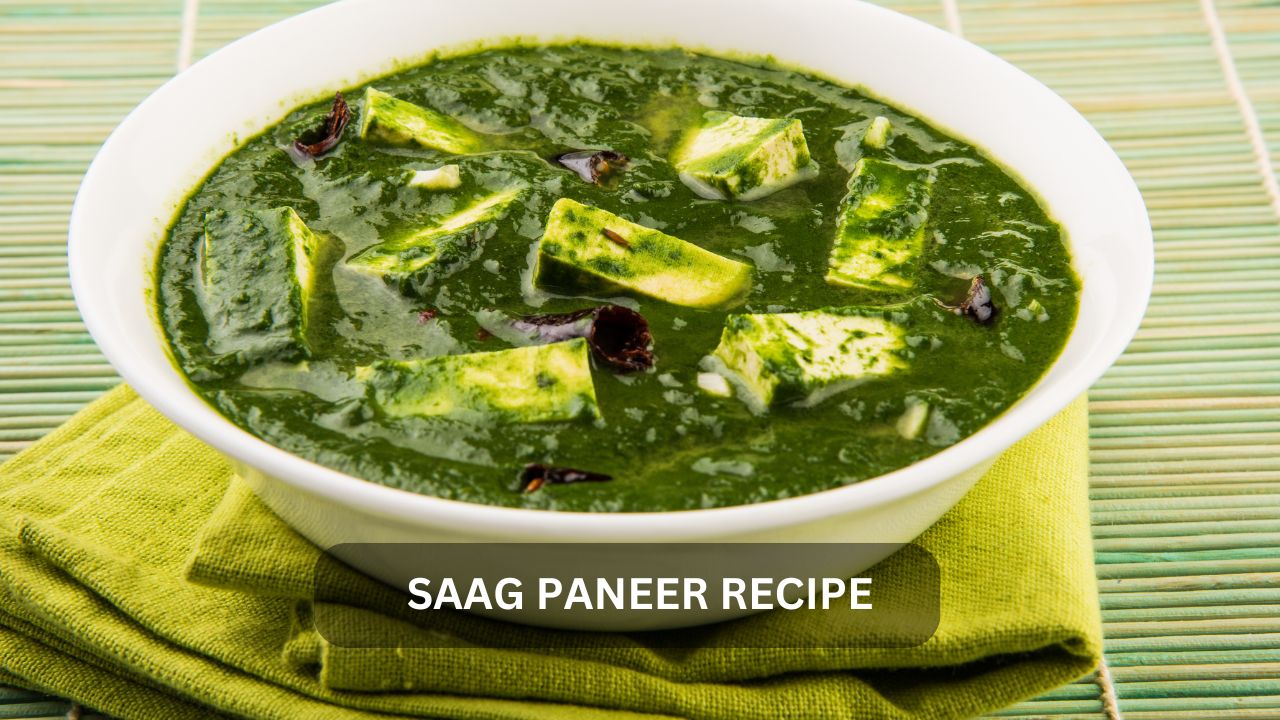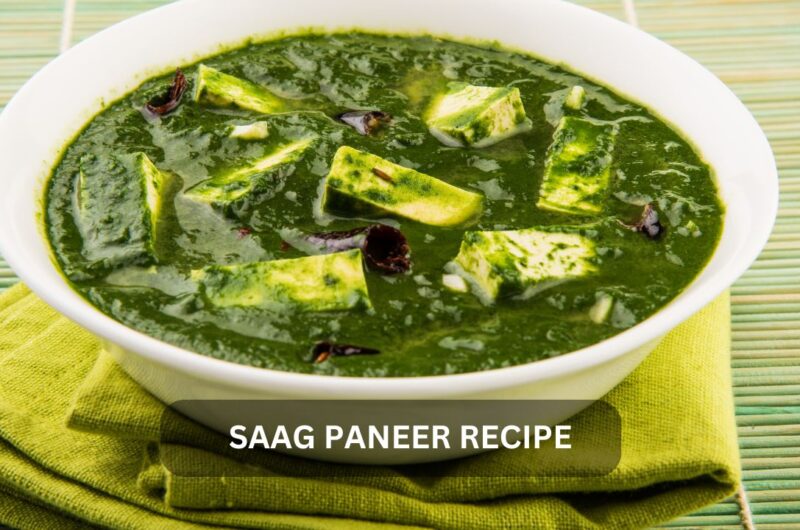An Introduction to Saag Paneer
A staple in the vibrant landscape of Indian cuisine, saag paneer recipe stands as a beloved dish that symbolizes comfort and celebration. Derived from two primary elements—’saag,’ which refers to a green leafy vegetable, predominantly spinach, and ‘paneer,’ a fresh cheese often lauded for its textural resilience—this dish seamlessly marries earthy, verdant flavors with the subtle creaminess of paneer. Served with zeal during festive occasions and a patron saint for vegetarians, the saag paneer recipe weaves a rich tapestry of culinary artistry, ancient roots, and contemporary appeal.
Historical Significance and Culinary Evolution
Saag paneer recipe refers to India’s agricultural traditions, where leafy greens were plentiful, and dairy was a revered diet component. Over the centuries, this dish has been meticulously crafted to embody the ethos of Indian cooking, highlighting regional flavors that transform it into a reflection of local identities and community pride.
Vegetarianism and the Rise of Paneer
The rise of vegetarianism as a dietary choice has seen the popularity of paneer soar. A precious source of protein in many Indian homes, it finds unique marriages, with sizzling skewers on the tandoor and the silken folds of saag. Paneer today is celebrated for its role in vegetarian cooking, affirming that meatless meals can be as hearty and satisfying as any meat-laden feast.
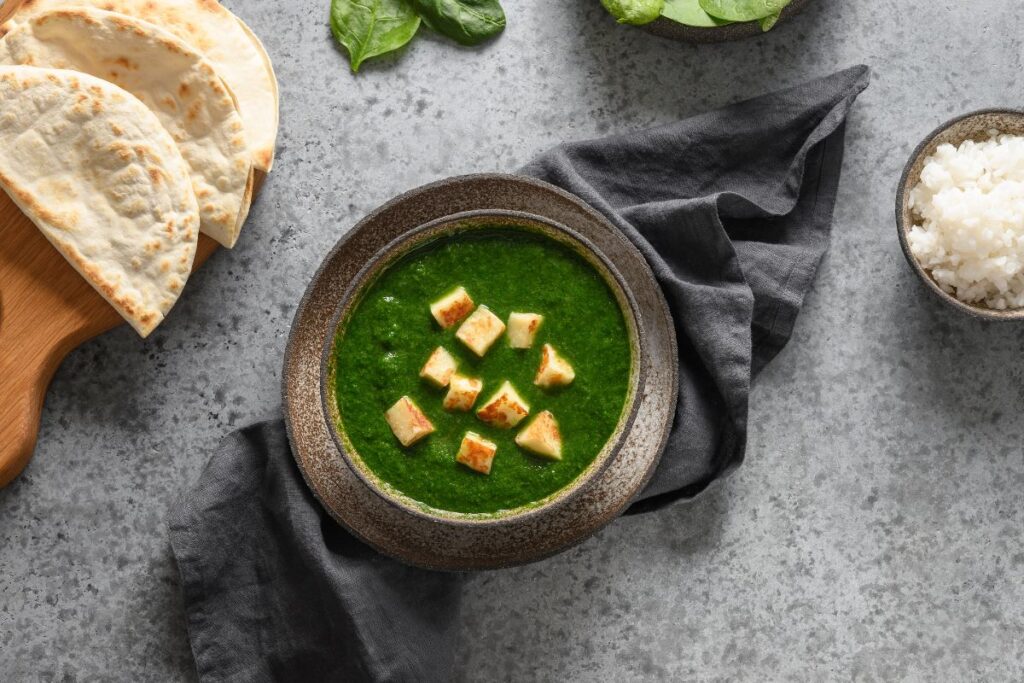
What is Saag Paneer?
Saag paneer is a beloved North Indian dish that features a delightful combination of spinach (saag) and paneer (a type of Indian cottage cheese). This dish stands out for its rich, creamy texture and complex flavors, which come from a blend of aromatic spices. The spinach provides a deep, earthy base, while the paneer adds a soft, mild contrast that melts in your mouth. Not only is saag paneer rich in flavor, but it’s also packed with essential nutrients like vitamins A and C, iron, and calcium, making it an excellent option for vegetarians and cheese enthusiasts looking for a hearty and healthy meal. Its balanced combination of taste and nutrition has made saag paneer a popular choice in both homes and restaurants across the globe.
The Traditional Saag Paneer Recipe
Ingredients That Tell a Story
Each ingredient in the saag paneer recipe contributes a distinct note, playing its part in a symphony of flavors. Fresh spinach, aromatic spices, and the wholesome goodness of homemade paneer fuse to create a dish that tantalizes the taste buds and nourishes the body.
Spinach:
Famed for its nutritional profile, spinach is the quintessential green used in saag paneer. Leafy, iron-rich, and versatile, spinach lends its vivid color and robust flavor, making for a wholesome vegetarian protein source.
Paneer:
The dish’s paneer star brings a mild creaminess that balances the saag’s bold flavors. Its gentle, milky taste serves as a canvas to absorb the piquancy of spices and the verdant essence of spinach.
Spice Blend:
Cumin, coriander, garam masala, and turmeric form the backbone of the spice blend, infusing saag paneer recipe with warmth and depth. The marriage of these spices tells stories of trade routes, ancient cuisines, and the genius of Indian alchemy in the kitchen.
Aromatics:
Onion, garlic, and ginger form the trinity of saag paneer’s aromatic base. Sauteed to a golden hue, they provide a robust foundation for the flavors to build upon.
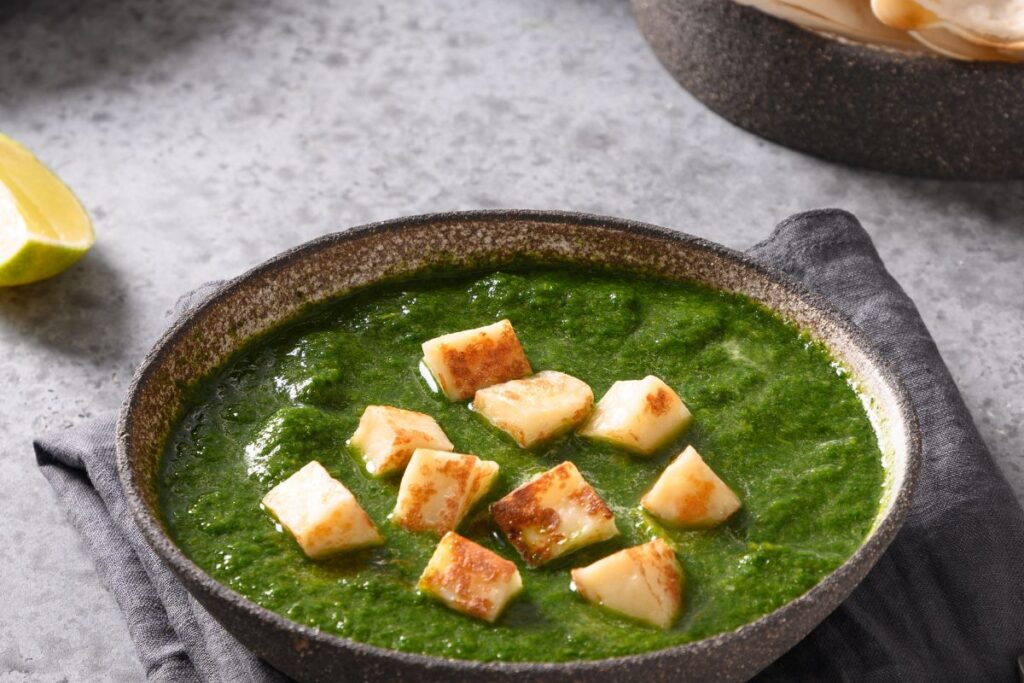
Cooking the Saag and Paneer
The saag paneer recipe assembly involves two key steps. First, the spinach is simmered until tender, then blended into a smooth puree. Second, the paneer is pan-fried to a golden crust, adding texture and a roasted taste to the otherwise creamy saag.
Step-by-Step Saag Paneer Recipe
- Preparing the Saag: Begin by simmering the spinach with the aromatics and spices until wilted. Then, blend into a puree, achieving a silky-smooth consistency.
- Frying the Paneer: In a separate pan, fry the paneer until golden on the outside, sealing in the moisture and developing a delightful texture contrast.
- Marriage in the Pot: Combine the pureed saag and golden paneer, allowing them to mingle over gentle heat. This stage is crucial—the saag should not be too runny or thick but just right to coat every morsel of paneer.
- Finishing Touch: Garnish your saag paneer with a dollop of cream or yogurt and a sprig of fresh cilantro. This final flourish completes the dish, adding a creamy tang and a fragrant herbaceous note.
Regional Variations
The beauty of Indian cuisine lies in its diversity, and saag paneer is no exception. From the robust mustard greens of Punjab to the delicate fenugreek leaves of Uttar Pradesh, the choice of greens can vary greatly. Spices and proportions also shift, offering a kaleidoscope of flavors from one region to the next. This section introduces readers to these regional nuances, encouraging experimentation to find a personal favorite.
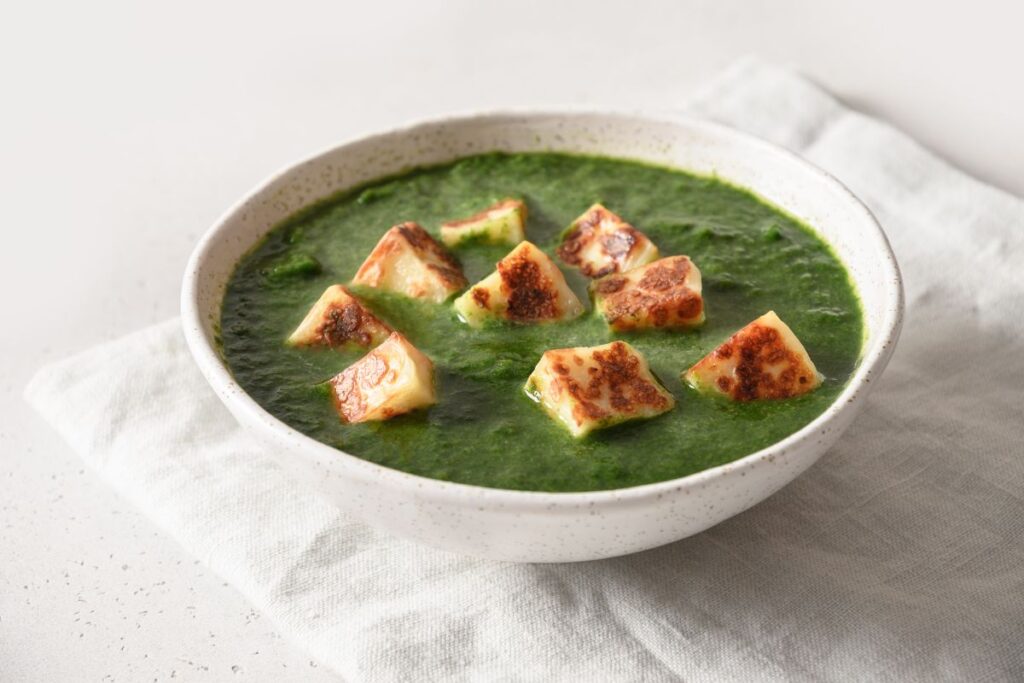
Variations and Customizations
Experimenting with Greens
While spinach is the go-to green for saag paneer, numerous options exist to personalize your dish. Try mustard greens for a peppery kick or amaranth leaves for a delicate flavor and a nutritional boost.
Elevating with Spices
Take control of the spiciness by adjusting the garam masala or adding chili for a hotter rendition. Roast and grind the spices for a fresher, more nuanced profile that will infuse every bite with your culinary signature.
The Vegan Twist
For those on a plant-based diet, saag paneer recipe can be converted into saag tofu by replacing the paneer with firm tofu. The result is just as satisfying, offering a twist that stays respectful to the original dish while opening its arms to a broader audience.
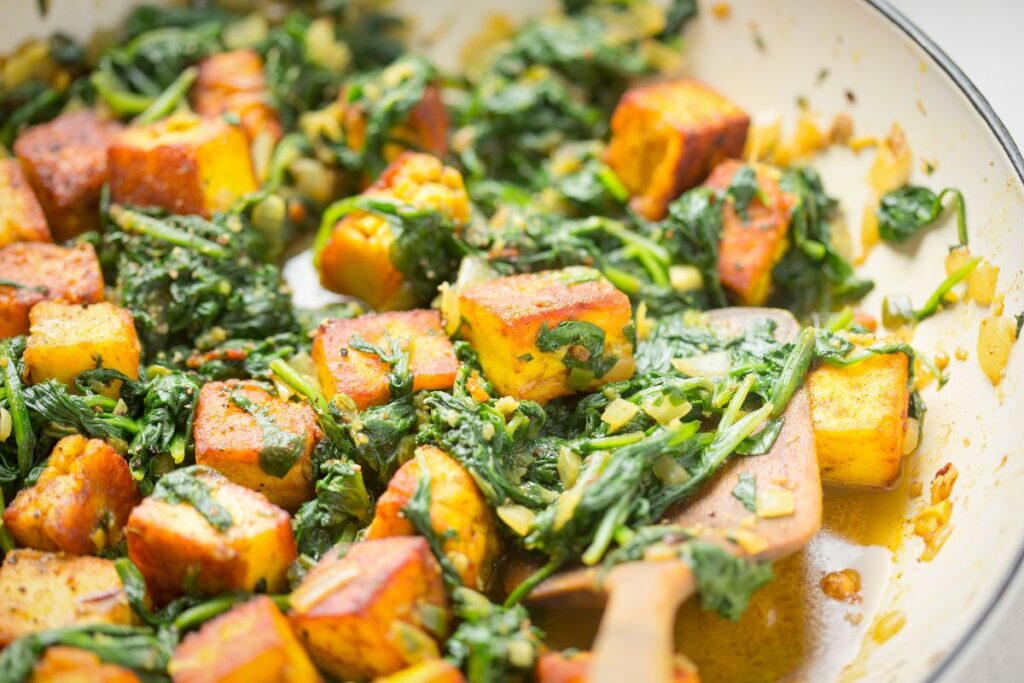
The Health Benefits of Saag Paneer
Nutritional Bonanza of Spinach
Spinach is a nutritional powerhouse packed with antioxidants, iron, vitamins A and C, and many other nutrients. When consumed as saag paneer, these benefits are complemented by the protein and calcium from the paneer, encouraging overall health and well-being.
Balancing Nutrition and Flavor
The addition of paneer provides protein, healthy fats, and calcium. When prepared with minimal oil, saag paneer can be a nutritious choice for those seeking a balanced diet. For heartier meals, pair with whole-grain rice or bread for a complete protein.
A Comparative View
When compared to other Indian dishes, saag paneer recipe emerges as a champion of health. It bypasses the heavier cream-based gravies, opting for yogurt or cream as a finishing touch. This section highlights saag paneer not only as a flavorful dish but also as a wise culinary choice for good health.
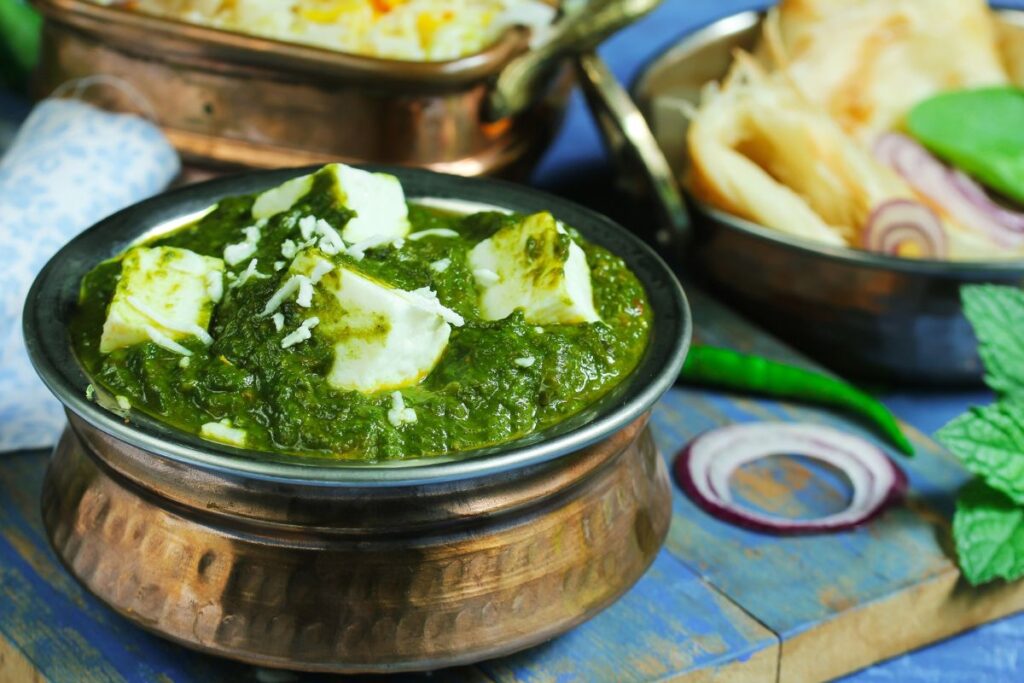
Tips for Perfecting Your Saag Paneer
Crafting the Perfect Paneer
Homemade paneer takes saag paneer recipe to the next level, offering a fresher and less rubbery texture than store-bought versions. This section provides a detailed tutorial on making paneer, instilling confidence in home cooks to produce this central ingredient.
Achieving the Right Consistency
The consistency of saag paneer is an art of balance. It should be thick enough to cling to the paneer but not so pulpy that it overwhelms the dish. Tips include simmering excess liquid and adjusting the quantity of greens for the right texture.
Freshness is Key
The amplitude of flavors in saag paneer is best appreciated when its components are fresh. Stale or wilted spinach, aged paneer, or oxidized spices can hamper the dish’s potential. This part emphasizes the importance of freshness in every element of the recipe.
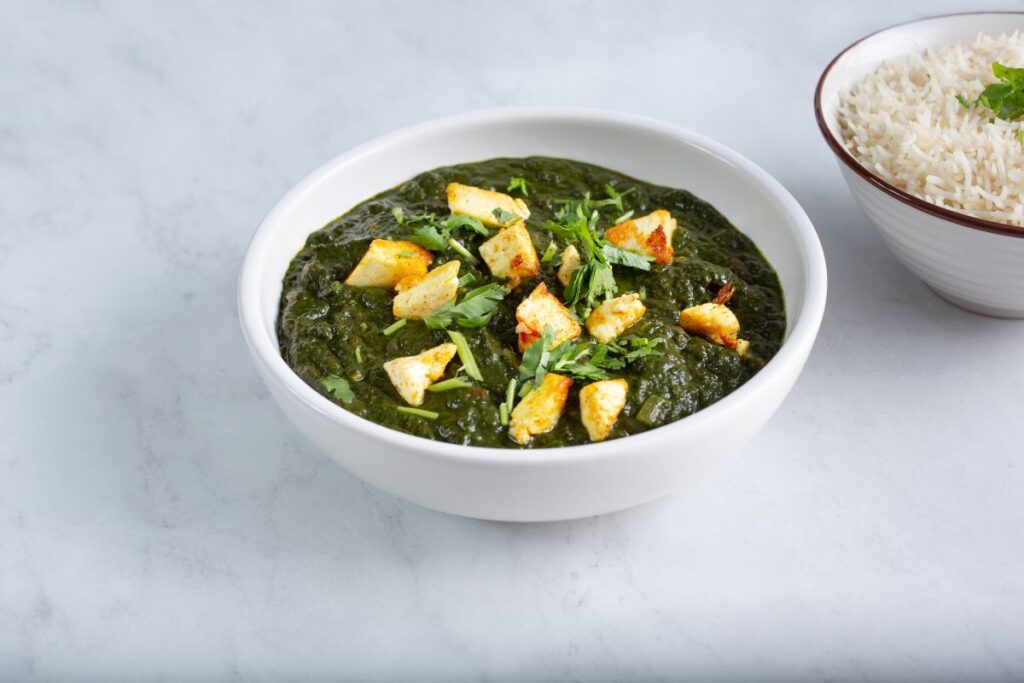
Serving Suggestions and Pairings
The Perfect Accompaniments
Saag paneer recipe shines with an array of Indian bread and rice varieties. From the craggy terrain of naan to the humble pav, these hand-held breads transform every morsel into a bite-sized delight. Basmati rice, with its fragrant grains that stand apart, or jeera rice, with its subtle cumin undertones, offer the perfect backdrop to saag paneer’s vibrant flavors.
Presentation Matters
In the world of saag paneer, the visual allure is just as essential as the taste. This section explores simple yet effective ways to present the dish, from decorative serving bowls to intricate garnishes, urging readers to elevate each dining experience to a moment of festivity.
Insights from the Indian Kitchen
This section shares insights and anecdotes from Indian kitchens, letting readers in on the little rituals and customs that make saag paneer more than just a meal. It’s a story shared around a communal pot, a recipe taught from one generation to the next, and a celebration in every serving.
Bringing It All Together
In the complex world of Indian cuisine, saag paneer recipe is an accessible triumph. It requires no specialized cooking skills or esoteric ingredients, only curiosity and a willingness to engage with a tradition that centers around sharing and savoring. This blog post arms readers with the knowledge and inspiration to dive into the rich culinary heritage that is saag paneer, guiding them toward a dish that is wholesome, flavorful, and deeply satisfying.
Through comprehensive insights into the origins, preparation, variations, health benefits, and serving suggestions of saag paneer, this long-form content not only enhances SEO and drives traffic but also provides a valuable resource for individuals seeking to master this iconic dish. Whether whipping it up for a quiet evening at home or sharing it on a special occasion, saag paneer embodies the very essence of Indian hospitality—offering warmth, nourishment, and the promise of many more shared meals to come.
Saag Paneer Recipe
Course: DinnerCuisine: IndiaDifficulty: Easy4
servings30
minutes27
minutes374
kcalAre you craving a delicious and flavorful Indian dish? Look no further! In this blog article, we will be exploring the wonderful world of saag paneer. Get ready to tantalize your taste buds with this amazing recipe!
Ingredients
Fresh spinach
Paneer
Onion
Garlic
Ginger
Green chilies
Garam masala
Turmeric powder
Cumin seeds
Salt
Oil
Directions
- Start by blanching the spinach in boiling water for a few minutes, then drain and set aside.
- In a pan, heat some oil and add the cumin seeds. Let them splutter.
- Add the chopped onion, garlic, and ginger to the pan. Sauté until golden brown.
- Add the chopped green chilies and cook for another minute.
- Now, add the blanched spinach to the pan and mix well with the other ingredients.
- Add the garam masala, turmeric powder, and salt. Mix well and cook for a few minutes.
- Finally, add the cubed paneer to the spinach mixture and gently stir to combine.
- Cook for another 2-3 minutes until the paneer is heated through.
- Serve hot with naan or rice.
Recipe Video
For more delicious homemade cook recipes, check out here-
- How to Cook Homemade Dauphinoise Potato Recipe
- How to Cook Creamy White Bean Chicken Chili Recipe
- How to Cook Baked Gnocchi Alfredo Recipe
- How to Cook Chicken Adobo Recipe
- How to Cook One-Pot Creamy Lemon Chicken & Asparagus Pasta
Conclusion
Saag paneer is a delightful and savory dish that masterfully combines the nutritional goodness of spinach with the smooth, creamy texture of paneer cheese. Originating from the vibrant culinary traditions of India, this dish stands out as a perfect choice not only for those seeking a hearty vegetarian meal but also as a rich and flavorful side dish that complements any main course beautifully. Rich in flavors and packed with wholesome ingredients, saag paneer invites you to explore the traditional tastes of India right in your own kitchen. So, why not seize the opportunity to immerse yourself in the culinary culture of India? Give saag paneer a try and let the symphony of spices and textures surprise your palate. Happy cooking, and may your kitchen be filled with the aromatic spices of India!
Reference
Frequently Asked Questions (FAQs) about Saag Paneer
Can I use frozen spinach instead of fresh spinach?
Yes, frozen spinach can be used as a substitute for fresh spinach in a saag paneer recipe. Ensure that the spinach is thoroughly thawed and excess water is squeezed out before use, to maintain the dish’s desired consistency.
How can I make saag paneer more flavorful?
To enhance the flavor of saag paneer, consider toasting your spices before adding them to the dish. Additionally, incorporating a small amount of kasuri methi (dried fenugreek leaves) towards the end of cooking can add a distinct, aromatic taste to the recipe.
Is saag paneer gluten-free?
Saag paneer is naturally gluten-free, as none of the primary ingredients contain gluten. However, if you’re using store-bought spices or paneer, it’s important to check labels for any added gluten-containing ingredients or cross-contamination warnings.
Can saag paneer be made vegan?
Yes, to make a vegan version of saag paneer, replace the paneer with firm tofu. For the best results, press the tofu to remove excess water and then pan-fry it until golden brown before adding it to the spinach mixture.
How long can saag paneer be stored in the refrigerator?
Saag paneer can be stored in an airtight container in the refrigerator for up to 3-4 days. Reheat gently before serving, adding a little water if necessary to adjust the consistency.

